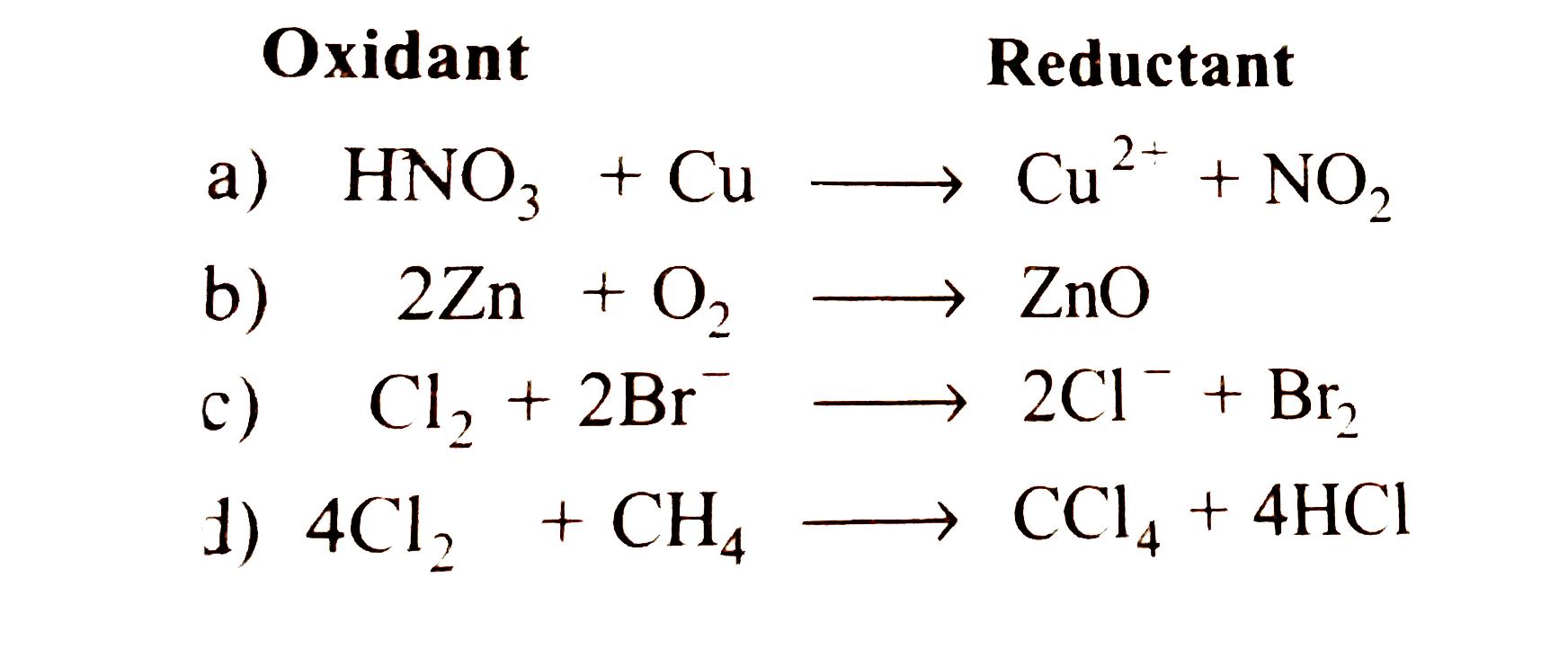Assertion : CuO(s)+H2(g)→Cu(s)+H2O(l). It is a redox reaction.
Reason : In a redox reaction, reductant is reduced by accepting electrons and oxidant is oxidised by losing electrons.
If both assertion and reason are true and reason is the correct explanation of assertion.
If both assertion and reason are true but reason is not the correct explanation of assertion.
If assertion is true but reason is false.
If both assertion and reason are false.
The correct Answer is:C
Reductant is oxidised by losing electrons and oxidant is reduced by accepting electrons. In a redox reaction, oxidation and reduction occur simultaneously.
Topper's Solved these Questions
- CHEMICAL REACTIONS AND EQUATIONSBOOK - MTG IIT JEE FOUNDATIONCHAPTER - CHEMICAL REACTIONS AND EQUATIONSEXERCISE - EXERCISE (COMPREHENSION TYPE)
6 Videos
- CHEMICAL REACTIONS AND EQUATIONSBOOK - MTG IIT JEE FOUNDATIONCHAPTER - CHEMICAL REACTIONS AND EQUATIONSEXERCISE - EXERCISE (VERY SHORT ANSWER TYPE)
16 Videos
- CHEMICAL REACTIONS AND EQUATIONSBOOK - MTG IIT JEE FOUNDATIONCHAPTER - CHEMICAL REACTIONS AND EQUATIONSEXERCISE - EXERCISE (MATCH THE FOLLOWING)
5 Videos
- CHEMICAL EQUILIBRIUMBOOK - MTG IIT JEE FOUNDATIONCHAPTER - CHEMICAL EQUILIBRIUMEXERCISE - EXERCISE (INTEGER/NUMERICAL VALUE TYPE)
5 Videos
- FOOTSTEPS TOWARDS (NEET) BOOK - MTG IIT JEE FOUNDATIONCHAPTER - FOOTSTEPS TOWARDS (NEET) EXERCISE - MCQ
45 Videos
Similar Questions
Knowledge Check
Assertion : In a reaction Zn(s)+CuSO4(aq)→ZnSO4(aq)+Cu(s),Zn is a reductant but itself get oxidized.
Reason : In a redox reaction, oxidant is reduced by accepting electrons and reductant is oxidized by losing electrons.AIf both assertion and reason are true and the reason is the correct explanation of the assertion.BIf both assertion and reason are true but reason is not the correct explanation of the assertion.CIf assertion is true but reason is false.DIf the assertion and reason both are false.Oxidation and reduction process involves the transaction of electrons. Loss of electrons is oxidation and the gain of electrons is reduction. It is thus obvious that in a redox reaction, the oxidant is reduced by accepting the electrons and the reductant is oxidised by losing electrons. The reactions in which a species disproportionates into two oxidation states (lower and higher) are called disproportionation reactions. In electrochemical cells, redox reaction is involved, i.e., oxidation takes place at anode and reduction at cathode.
Detennine the change in oxidation number of sulphur in H2SandSO2 respectively in the following reaction:
2H2S+SO2→2H2O+3SA0,+2B+2,−4C−2,+2D+4,0Oxidation and reduction process involves the transaction of electrons. Loss of electrons is oxidation and the gain of electrons is reduction. It is thus obvious that in a redox reaction, the oxidant is reduced by accepting the electrons and the reductant is oxidised by losing electrons. The reactions in which a species disproportionates into two oxidation states (lower and higher) are called disproportionation reactions. In electrochemical cells, redox reaction is involved, i.e., oxidation takes place at anode and reduction at cathode.
In the reaction:
I2+2S2O2−3→2I−+S4O2−6AI2 is a reducing agentBI2 is an oxidising agentCS2O2−3 is a reducing agentDS2O2−3 is an oxidising agent
Oxidation and reduction process involves the transaction of electrons. Loss of electrons is oxidation and the gain of electrons is reduction. It is thus obvious that in a redox reaction, the oxidant is reduced by accepting the electrons and the reductant is oxidised by losing electrons. The reactions in which a species disproportionates into two oxidation states (lower and higher) are called disproportionation reactions. In electrochemical cells, redox reaction is involved, i.e., oxidation takes place at anode and reduction at cathode.
The reaction Cl2→Cl−+ClO−3 is:
View SolutionOxidation and reduction process involves the transaction of electrons. Loss of electrons is oxidation and the gain of electrons is reduction. It is thus obvious that in a redox reaction, the oxidant is reduced by accepting the electrons and the reductant is oxidised by losing electrons. The reactions in which a species disproportionates into two oxidation states (lower and higher) are called disproportionation reactions. In electrochemical cells, redox reaction is involved, i.e., oxidation takes place at anode and reduction at cathode.
Which of the following reactions is/are correctly indicated?

View SolutionOxidation and reduction process involves the transaction of electrons. Loss of electrons is oxidation and the gain of electrons is reduction. It is thus obvious that in a redox reaction, the oxidant is reduced by accepting the electrons and the reductant is oxidised by losing electrons. The reactions in which a species disproportionates into two oxidation states (lower and higher) are called disproportionation reactions. In electrochemical cells, redox reaction is involved, i.e., oxidation takes place at anode and reduction at cathode.
Select the correct statement:
View SolutionAssertion : 2H2S(g)+O2(g)→2S(s)+2H2O(l). It is a redox reaction.
Reason : Oxidation involves removal of hydrogen while reduction involves addition of hydrogen.
View SolutionAssertion: 2H2S(g)+O2(g)→2S(s)+2H2O(l)
It is an oxidation reaction.
Reason:Oxidation is a process which involves removal of hydrogen
View Solution
